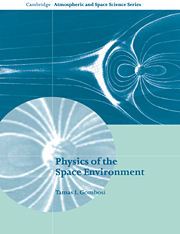Chapter 8 - The Terrestrial Upper Atmosphere
Published online by Cambridge University Press: 22 October 2009
Summary
Sidney Chapman introduced the nomenclature used to describe the various regions of the upper atmosphere. The classification is primarily based on the variation of temperature with altitude. In this system the regions are called “spheres” and the boundaries between the regions are called “pauses.”
The troposphere (in Greek it means “turning sphere”) is the lowest atmospheric region. It begins at the surface (which provides the major heat source for the atmosphere) and extends to about 10–12 km. This region is mainly characterized by a negative temperature gradient (≈ -10 K/km). The troposphere is bounded by the tropopause, which separates the troposphere from the stratosphere (Greek word for “layered sphere”). The temperature at the tropopause is about 200 K. Originally the stratosphere was thought to be isothermal, but in fact, in this region the temperature increases about 2 K/km due to the absorption of solar UV radiation by stratospheric ozone. Stratospheric ozone is particularly important because it absorbs UV radiation harmful to life.
The maximum temperature (≈270 K) is reached at the stratopause, which is located at around 50 km altitude. Above the stratosphere lies the mesosphere (middle atmosphere), where the temperature again decreases with altitude. The temperature reaches its minimum (≈180 K) at the mesopause, located at an altitude of about 85 km.
- Type
- Chapter
- Information
- Physics of the Space Environment , pp. 125 - 157Publisher: Cambridge University PressPrint publication year: 1998



